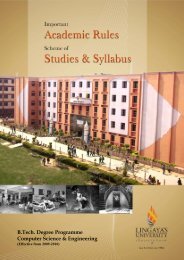Electrical and Electronics - Lingaya's University
Electrical and Electronics - Lingaya's University
Electrical and Electronics - Lingaya's University
Create successful ePaper yourself
Turn your PDF publications into a flip-book with our unique Google optimized e-Paper software.
Lingaya’s <strong>University</strong>, Faridabadcalled upon to learn the rudiments of measurementsvery early in their study period.1. UNITS, STANDARDS & MEASUREMENTERROR: S. I. Units; accuracy & precision; error &correction; significant figures; types of errors –gross, systematic& r<strong>and</strong>om; types of st<strong>and</strong>ards;constructional aspects (only general features) ofprimary st<strong>and</strong>ards; absolute determination ofresistance; resistance st<strong>and</strong>ards; primary <strong>and</strong>laboratory st<strong>and</strong>ards of e.m.f.2. MEASURING SYSTEM FUNDAMENTALS: Thegeneralized instrumentation system block diagram &description of blocks; classification of Instruments(Absolute & Secondary Instruments); Indicating,Recording & Integrating instruments (Based uponPrinciple of operation); three forces inelectromechanical indicating instrument (Deflecting,controlling & damping forces), Comparison betweengravity & spring controls; comparison of dampingmethods & their suitability; bearing supports, pivotlesssupports (Simple & taut-b<strong>and</strong>); Scaleinformation; Instrument cases (Covers).3. MEASURING INSTRUMENTS: Galvanometers – D‗Arsonval, ballistic <strong>and</strong> vibration galvanometers,construction <strong>and</strong> theory; Ammeter <strong>and</strong> Voltmeters –general constructional features, operating principle,torque equation, shape of scale; advantages <strong>and</strong>disadvantages of PMMC type, electro dynamic type,moving iron type (attraction & repulsion), inductiontype <strong>and</strong> rectifier type instruments; errors (both onAC/DC type); extension of instrument range – shunts<strong>and</strong> multirange ammeters, voltmeter multipliers;potential divider arrangement; sensitivity; multimeters.4. MEASUREMENT OF POWER AND ENERGY:Electro dynometers type wattmeter; low powerfactor wattmeter; reactive power measurements;induction type energy meter – construction, theory,errors <strong>and</strong> adjustments, calibration.5. MEASUREMENT OF RESISTANCE,INDUCTANCE AND CAPACITANCE: Wheatstonebridge; limitations; sensitivity analysis; Kelvin‘sdouble bridge; earth resistance measurement;measurement of insulation resistance; a st<strong>and</strong>ardinductor; frequency error in inductance <strong>and</strong>capacitor; general considerations of inductance<strong>and</strong> capacitance comparison bridges; Andersonbridge; Hay‘s bridge; Wein‘s bridge; Scheringbridge; detectors used in A.C. bridges; errors inbridge measurements <strong>and</strong> precautions to be takenin minimizing errors or eliminations; Wagner‘searthing device <strong>and</strong> shielding.6. INSTRUMENTS TRANSFORMERS: Current <strong>and</strong>potential transformers; ratio <strong>and</strong> phase angleerrors; construction, theory; use of instrumenttransformers for measurement of power.7. MAGNETIC MEASUREMENTS: Construction &working of Flux meter; determination of B-H Curve<strong>and</strong> hysteresis loop. Determination of iron lossesby Lloyd Fisher Square; separation of iron losses.TEXT BOOKSawhney, A. K., ―A Course in <strong>Electrical</strong> <strong>and</strong> ElectronicMeasurements & Instrumentation‖, Dhanpat Rai &Sons, New Delhi, 2009.REFERENCE BOOKS1. An<strong>and</strong>, M.M.S., ―Electronic Instruments <strong>and</strong>Instrumentation Technology‖, Prentice-Hall ofIndia, Pvt. Ltd. 2005.2. Northrop, Robert B, ―Introduction toInstrumentation <strong>and</strong> Measurements‖, 2 nd Edition,CRC Press, Taylor & Francis Group Special IndianEdition, 2008.3. Helfric A. D. & Cooper W. D., ―Modern ElectricInstrumentation & Measuring Instruments‖,Prentice Hall of India, 2003.4. Golding, E. W. & Widdis F. C., ―<strong>Electrical</strong>Measuring Instruments & Measurements‖, WheelerPublishing Company.EE-202ELECTRICAL NETWORKTHEORYL T P Cr5 0 0 3OBJECTIVESElectric networks make up an inseparable part of theelectric gadgets <strong>and</strong> equipment of modern –day living.An electric system without network is un-imaginable.This subject provides an in-depth underst<strong>and</strong>ing of thetheoretical concepts <strong>and</strong> practical applications ofcircuits <strong>and</strong> their analysis – which are very essential tograsp the fundamentals of other disciplines ofengineering such as communications, power systems<strong>and</strong> computer etc.1. NETWORK ANALYSIS: Independent <strong>and</strong>dependent voltage <strong>and</strong> current sources; circuitanalysis with independent & dependentsources – Mesh current <strong>and</strong> node voltageanalysis, Thevinin‘s <strong>and</strong> Norton‘s theorems;maximum power transfer theorem & impedancematching; superposition principle; Tellegen‘stheorem; network graphs <strong>and</strong> definitions;branch to node incidence matrix; reducedincidence matrix; branch to loop incidencematrix; cut set matrix; Kirchhoff‘s laws; networkequilibrium equations.2. POLYPHASE SYSTEMS: Double-subscriptnotation; phase sequence; voltage relations inbalanced – Wye system <strong>and</strong> delta systems; currentrelations in Wye <strong>and</strong> delta systems; current in theneutral of unbalanced Wye systems; Unbalanced3-wire, <strong>and</strong> 4-wire Wye-Wye systems; Unbalanceddelta systems – fixed voltages assumed at the loadterminals; combination of single – phase along withbalanced three phase loads; problem of neutralshift; residential circuits wiring.3. TRANSIENT RESPONSE: Capacitive transients –v-i relationships; circuit model of chargedcapacitor, capacitive power, energy, stored incapacitance; Inductive transients – v-irelationships, circuit model of fluxed inductor,inductive power, energy stored in inductance;comparison of capacitive <strong>and</strong> inductive v-irelationships; transient response of RC, RL, RLCcircuits to various excitation signals such as step,impulse <strong>and</strong> sinusoidal excitations using LaplaceTransform.4. TWO PORT NETWORKS: Type of problems;representation of networks; two port networkparameters –short circuit admittance, open circuitimpedance, ABCD, transmission <strong>and</strong> hybridparameters; relationship between parameter sets;9
















